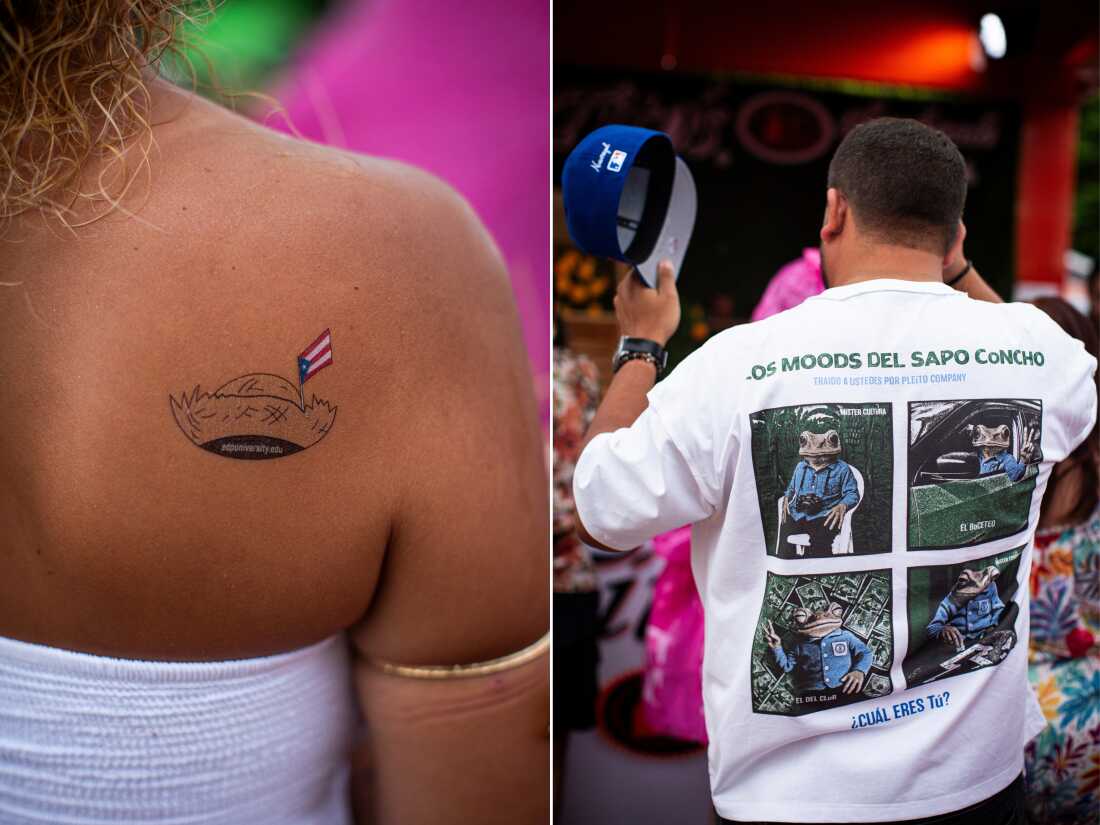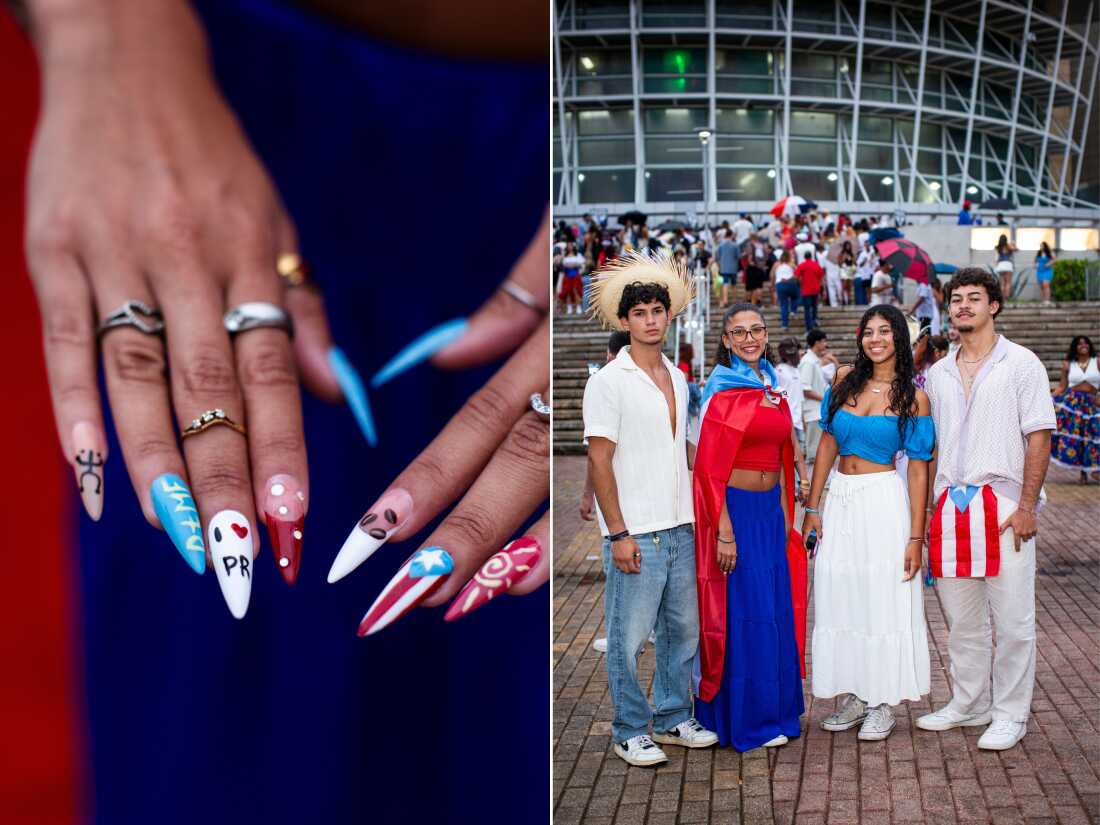Dangerous Bunny’s live performance, titled “No Me Quiero Ir De Aquí” (“I Do not Need To Go away Right here”), is a love letter to Puerto Rico, and particularly to the numerous hundreds of Puerto Ricans who’ve been pressured to go away their island in quest of financial alternative elsewhere, or are going through strain to make that call.
Erika P. Rodríguez for NPR/NPR
disguise caption
toggle caption
Erika P. Rodríguez for NPR/NPR
SAN JUAN, P.R. — Michelle García Mercado stepped off the airplane from Orlando, and her physique, lastly, felt comfy. She was in Puerto Rico. She was residence.
“I really feel at peace,” she stated. “I really feel pleased for the primary time in months.”
She got here again to the island primarily to attend one of many 30 live shows that the worldwide famous person Dangerous Bunny is performing in San Juan this summer season.

Followers dance and sing throughout Dangerous Bunny’s efficiency on the Jose Miguel Agrelot Coliseum in San Juan on July 27.
Erika P. Rodríguez for NPR/NPR
disguise caption
toggle caption
Erika P. Rodríguez for NPR/NPR

Jason Domenech Nazario, 27, and Michelle García Mercado, 29, are longtime associates who reunited after they each flew again to Puerto Rico for Dangerous Bunny’s live performance. He lives and works in Boston. She, in Orlando.
Erika P. Rodríguez for NPR
disguise caption
toggle caption
Erika P. Rodríguez for NPR
However García Mercado’s lengthy weekend go to was a scheduling frenzy, because the 29-year-old maneuvered to fill each open second with household, associates, and visits to her favourite hangout spots. She wished to soak within the folks and locations her coronary heart has ached for within the three years since she reluctantly moved away.
García Mercado is only one of so many Puerto Ricans who’ve felt pressured to go away their island due to a scarcity of financial alternative amid its decades-long debt disaster, worsening infrastructure, rising costs amid a wave of gentrification, and deteriorating providers.
That is why Dangerous Bunny’s resolution to play all 30 live shows on the island has been so groundbreaking. It is introduced again many hundreds of Puerto Ricans who’ve moved away, and is mending a few of their sorrow over that call to go away.

The woven “pava” has lengthy been an emblem of delight in Puerto Rico’s agrarian historical past. Dangerous Bunny’s newest album, showcasing Puerto Rico’s traditions, has led many younger folks to start carrying it.
Erika P. Rodríguez for NPR/NPR
disguise caption
toggle caption
Erika P. Rodríguez for NPR/NPR

The “pava,” left, and the “sapo concho”, an endangered native frog that has emerged as one other image of Puerto Rican delight due to Dangerous Bunny’s embrace of it.
Erika P. Rodríguez for NPR
disguise caption
toggle caption
Erika P. Rodríguez for NPR

Individuals wait outdoors San Juan’s Jose Miguel Agrelot Coliseum, often called ‘El Choli’, earlier than a latest Dangerous Bunny live performance.
Erika P. Rodríguez for NPR/NPR
disguise caption
toggle caption
Erika P. Rodríguez for NPR/NPR

Jhael Amir, from the municipality of Cayey, supplied haircuts earlier than a latest live performance.
Erika P. Rodríguez for NPR/NPR
disguise caption
toggle caption
Erika P. Rodríguez for NPR/NPR
A cathartic expertise
The residency’s very title hints at these wounds: “No Me Quiero Ir De Aqui” – “I Do not Need To Go away Right here.”
From the stage, Dangerous Bunny addresses the harm instantly.
“To these of us who’ve needed to depart, however dream of returning,” he stated to his viewers towards the tip of 1 latest live performance, “and to these of us who’re nonetheless right here. We do not wish to depart! We’re nonetheless right here!”
He then launched into the title track of his newest album, a nostalgic observe about wishing you’d taken extra photographs of the folks you have misplaced. Throughout the sector, folks embraced their associates, kissed their grandmothers, and cried into the arms of their moms. It was a communal catharsis.

Jorge Vidal, Alaila Méndez, Carla Rodríguez and Alejandro Barker, all 18-year-olds from the capital, pose for a portrait earlier than attending Dangerous Bunny’s live performance in late July.
Erika P. Rodríguez for NPR
disguise caption
toggle caption
Erika P. Rodríguez for NPR

Dangerous Bunny’s live performance is a celebration of conventional Puerto Rican rhythms, together with the bomba that was first danced by enslaved Africans alongside the island’s coasts.
Erika P. Rodríguez for NPR/NPR
disguise caption
toggle caption
Erika P. Rodríguez for NPR/NPR
“It is that feeling of melancholy that so many individuals really feel over a world that’s slipping away from them,” stated Yarimar Bonilla, a Princeton political anthropologist who has seen the present just a few instances. “We’re all affected by a heartbreak over our homeland.”
Dangerous Bunny is telling followers it does not matter the place they reside, Bonilla stated, they’re no much less Puerto Rican. That reassurance has been like a therapeutic balm for the souls of many who’ve left or who have been born some other place, and who’ve harbored guilt or self-doubt about their Puerto Rican id consequently.
“For these of us within the diaspora, it appears like we have been forgiven,” Bonilla stated. “It is like a recognition that we left unwillingly, that we have by no means forgotten this place, that we’re nonetheless part of it.”

A fan takes a photograph.
Erika P. Rodríguez for NPR/NPR
disguise caption
toggle caption
Erika P. Rodríguez for NPR/NPR

The principle stage on the live performance is designed to appear like a scene from Puerto Rico’s countryside. The flamboyán tree, with its sensible blooms, has lengthy impressed music, poetry and reverence for the fantastic thing about the island’s landscapes.
Erika P. Rodríguez for NPR/NPR
disguise caption
toggle caption
Erika P. Rodríguez for NPR/NPR
Dedication and resistance
The live performance is a pulsating celebration of Puerto Rican traditions and rhythms, amongst them salsa, plena, bomba and reggaeton. And it is giving younger folks, particularly, a renewed sense of delight and function.
García Mercado, the 29-year-old who left for Orlando, stated she’s now extra decided to completely transfer again to Puerto Rico.
“I will make a plan,” she stated.
Her buddy, Jason Domenech, 27, who left to check and work in Boston, stated that, not like many Puerto Ricans within the diaspora, he doesn’t usually put on or show the Puerto Rican flag. However when he returned residence for the live performance final month, he purchased a designer shirt that made a delicate reference to the flag’s stripes and colours.
“It was the primary time that I used to be like, I wish to scream that I am Puerto Rican,” he stated. “However with out being tremendous loud about it, you recognize?”

Camila Gallardo, Angeline Mundo, Io Gonzalez and Eliud Diaz returned to Puerto Rico from Miami for the live performance. Mundo left Puerto Rico in 2014, and introduced her daughters to the present as a result of she desires them to like their tradition.
Erika P. Rodríguez for NPR
disguise caption
toggle caption
Erika P. Rodríguez for NPR

Dancing to the rhythm of plena earlier than the live performance.
Erika P. Rodríguez for NPR/NPR
disguise caption
toggle caption
Erika P. Rodríguez for NPR/NPR
Tanisha Galarza, a 23-year-old from Guayanilla, a city on the island’s southern coast, attended the live performance together with her mom. They cried by means of a lot of it.
Galarza is a budding musician who performs the cuatro, a Puerto Rican folks guitar. She desires to make her profession in Puerto Rico however has generally frightened that she, like just a few members of her household, might have to go away to get forward. She left the live performance feeling impressed to do every part she may to remain.
“It is an incredible feeling,” she stated.

Followers earlier than a latest live performance.
Erika P. Rodríguez for NPR
disguise caption
toggle caption
Erika P. Rodríguez for NPR

Capturing recollections earlier than a latest live performance.
Erika P. Rodriguez for NPR/NPR
disguise caption
toggle caption
Erika P. Rodriguez for NPR/NPR
Angeline Mundo and her household moved to Miami in 2014. She, her husband, and her daughters got here again for the present.
“I attempt to determine every single day a technique to return to my homeland,” she stated. “I introduced my household to the live performance as a result of I wish to educate my daughters to like their tradition, to like who we’re.”
She stated her older daughter, a youngster, has taken a renewed curiosity in Puerto Rican tradition due to Dangerous Bunny.
“He is completed one thing that nobody else has been capable of do,” she stated. “He is revived that delight in everybody — younger folks, previous folks, medical doctors, folks from the neighborhood. Everybody.”

Dangerous Bunny atop a typical Puerto Rican home that was constructed onto the sector flooring for his 30-concert residency.
Erika P. Rodríguez for NPR/NPR
disguise caption
toggle caption
Erika P. Rodríguez for NPR/NPR

